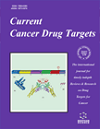- Home
- A-Z Publications
- Current Cancer Drug Targets
- Previous Issues
- Volume 13, Issue 1, 2013
Current Cancer Drug Targets - Volume 13, Issue 1, 2013
Volume 13, Issue 1, 2013
-
-
Mechanistic Insights into the Antileukemic Activity of Hyperforin
More LessAuthors: C. Billard, F. Merhi and B. BauvoisHyperforin is a prenylated phloroglucinol present in the medicinal plant St John's wort (Hypericum perforatum). The compound has many biological properties, including antidepressant, anti-inflammatory, antibacterial and antitumor activities. This review focuses on the in vitro antileukemic effects of purified hyperforin and related mechanisms in chronic lymphoid leukemia (CLL) and acute myeloid leukemia (AML) - condition Read More
-
-
-
Safety and Proof-of-Concept Efficacy of Inhaled Drug Loaded Nano- and Immunonanoparticles in a c-Raf Transgenic Lung Cancer Model
More LessAuthors: Nour Karra, Taher Nassar, Florian Laenger, Simon Benita and Juergen BorlakPulmonary delivery of drug-loaded nanoparticles is a novel approach for lung cancer treatment and the conjugation of nanoparticles to a targeting ligand further promotes specificity of the carrier cargo to cancer cells. Notably, the epithelial cell adhesion molecule (EpCAM, CD326) is over expressed in lung cancer. Here, we report the safety and proof-of-concept efficacy of drug-loaded nanoparticles and EpCAM immunona Read More
-
-
-
Targeted Anti-leukemic Therapy as Disease-stabilizing Treatment for Acute Myeloid Leukemia Relapse after Allogeneic Stem Cell Transplantation: Will it be Possible to Combine these Strategies with Retransplantation or Donor Lymphocyte Infusions?
More LessAllogeneic stem cell transplantation is commonly used in the treatment of high-risk acute myeloid leukemia (AML). This intensive treatment has a high early transplant-related mortality, and an additional significant cause of death in these patients is later AML relapse. Retransplantation can be considered for a minority of patients, but only 10-20% of selected patients then achieve long-term survival. Donor lymphocyte infusion ( Read More
-
-
-
Inhibition of Cdc42-Interacting Protein 4 (CIP4) Impairs Osteosarcoma Tumor Progression
More LessAuthors: Nadezhda V. Koshkina, Ge Yang and Eugenie S. KleinermanBackground: In patients with Osteosarcoma (OS), larger primary tumor size correlates with higher metastasis incidence and lower overall survival. Identifying the mechanisms that control primary tumor growth can lead to the new therapeutic approaches and improve prognosis. Cytoskeleton regulatory molecules play an important role in tumor cells proliferation and motility. In the current study, we investigated the role of sca Read More
-
-
-
Inhibition of STAT Signalling in Bladder Cancer by Diindolylmethane - Relevance to Cell Adhesion, Migration and Proliferation
More LessEffective treatments to prevent recurrence or progression of non-muscle-invasive bladder cancer, or to inhibit metastasis of muscle-invasive forms of the disease, would deliver significant patient benefit. Here the involvement of STAT signalling and the chemopreventive potential of diindolylmethane (DIM) in human bladder cancer were investigated. Muscle-invasive bladder cancer tissues were characterised by nucle Read More
-
-
-
Multifaceted Mechanisms for Cell Survival and Drug Targeting in Chronic Myelogenous Leukemia
More LessAuthors: J. Kuroda, Y. Shimura, M. Yamamoto-Sugitani, N. Sasaki and M. TaniwakiTreatment outcomes for chronic myelogenous leukemia (CML) have shown major improvements as a result of the development of the tyrosine kinase inhibitors (TKIs) imatinib, nilotinib and dasatinib for the disease-specific molecular target BCR-ABL1 tyrosine kinase (TK), but a cure of CML by BCR-ABL1 TKIs has been rarely achieved. CML cells are protected from cytotoxic insults, including those by TKIs, through various coll Read More
-
-
-
Apoptosis Suppression by Candidate Oncogene PLAC8 is Reversed in Other Cell Types
More LessTargets for cancer therapy are conventionally selected by identification of molecules acting downstream of established tumour suppressors and oncoproteins, such as p53, c-Myc and Ras. However, the forward genetics approach provides an alternative, conceptually distinct, strategy for identifying target molecules de novo. This approach, which uses unbiased selection protocols relying directly on the effects of the genes Read More
-
-
-
Experimental Therapy for Lung Cancer: Umbilical Cord-Derived Mesenchymal Stem Cell-Mediated Interleukin-24 Delivery
More LessAuthors: Xu Zhang, Leilei Zhang, Wenrong Xu, Hui Qian, Shengqin Ye, Wei Zhu, Hongcui Cao, Yongmin Yan, Wei Li, Mei Wang, Wei Wang and Ruiwen ZhangThe use of adult stem cells as gene delivery vehicles is a novel and attractive strategy for cancer therapy. Mesenchymal stem cells (MSCs) provide a promising source for stem cell-based gene therapies. Interleukin-24 (IL24) has been suggested as an effective anticancer agent. However, a lack of tumor-targeted delivery and a host immune response to viral vehicles has hindered its application for cancer therapy. In this study, w Read More
-
-
-
TRPC Channels and Their Splice Variants are Essential for Promoting Human Ovarian Cancer Cell Proliferation and Tumorigenesis
More LessAuthors: Bo Zeng, Cunzhong Yuan, Xingsheng Yang, Stephen L. Atkin and Shang-Zhong XuTRPC channels are Ca2+-permeable cationic channels controlling Ca2+ influx response to the activation of G protein-coupled receptors and protein tyrosine kinase pathways or the depletion of Ca2+ stores. Here we aimed to investigate whether TRPC can act as the potential therapeutic targets for ovarian cancer. The mRNAs of TRPC1, TRPC3, TRPC4 and TRPC6 were detected in human ovarian adenocarcinoma. The spliced vari Read More
-
Volumes & issues
-
Volume 25 (2025)
-
Volume 24 (2024)
-
Volume 23 (2023)
-
Volume 22 (2022)
-
Volume 21 (2021)
-
Volume 20 (2020)
-
Volume 19 (2019)
-
Volume 18 (2018)
-
Volume 17 (2017)
-
Volume 16 (2016)
-
Volume 15 (2015)
-
Volume 14 (2014)
-
Volume 13 (2013)
-
Volume 12 (2012)
-
Volume 11 (2011)
-
Volume 10 (2010)
-
Volume 9 (2009)
-
Volume 8 (2008)
-
Volume 7 (2007)
-
Volume 6 (2006)
-
Volume 5 (2005)
-
Volume 4 (2004)
-
Volume 3 (2003)
-
Volume 2 (2002)
-
Volume 1 (2001)
Most Read This Month
Article
content/journals/ccdt
Journal
10
5
false
en


